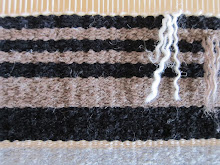I have been getting emails from readers who can't get their comments posted and I thought I would share this one with you, from Ruby Leslie, a well-known weaver who I have met since moving to Vermont. Commenting on the use of weft materials, she wrote:
"In the early '80's Dini Moes wove a plastic raincoat using saran wrap in the warp and dry cleaner bags in the weft. She wrote up the project in a Weavers Journal back then. I remember seeing the raincoat in a workshop with her when I was a new weaver, and was totally impressed with how unique it was."
I continue to weave place mats. The other morning I was up at the loom at 7:30 a.m. (unheard of for me) and wove two before going to water aerobics (me as Esther Williams). The other day I mentioned being concerned about finishing these mats. I have lots of cloth I have woven sitting in boxes which I intend to "finish" someday but pulling out thread and needle to hem them seems to be very difficult for me. I like weaving cloth that can be used with the minimal amount of fussing and finishing. I seem to be able to do knots, or machine sew a small zig zag, and I can spend days on tops and bottoms of the woven hangings, but the idea of a neat, crisp casing sewn around a place mat will not do for me. I want the selvedge edge to be neat enough to leave alone.
I am a rehearser. I get into bed and go over things to do, worry them into solutions. So I thought about the simple basket weave mat that I wanted, and finally considered using two shuttles. Which I did the other morning and the results were good. I always threw the shuttle on the left first (left to right), then with same shed open, I threw the shuttle on right (right to left), catching it around the first weft. You can see what I mean in the image below, and the body of the basket weave in the image below it. In this case, using two shuttles did make the yarn lie flat, side by side, just as I wanted it to be.


Another person who contacted me because of the blog is an old friend, Fern Devlin. In the mid-80's I did some production weaving for Fern, who creates beautiful scarfs. At first I made the mistake of taking her warps home and weaving them on my table loom. You build up a rhythm of work on that loom--hand up to change shed, hand down to pick up shuttle, throw shuttle, catch shuttle, beat, shuttle down, hand up to change shed--but you can't build up speed. It didn't take long before I was weaving for her in her studio on one of her floor looms. Fern has a very interesting blog, and she referred me to a post she did on a mutual friend, Ann Rosenthal. Ann has always had such a cleaver mind, thinking of games to create and solve in her weaving. I think she showed me how to swap out threads in a warp, and I used this idea in one of my mats the other morning. I wanted these thin black lines added to a white ground, to mimic the incised lines of some of Holly's plates. So I added two chenille black warps into the same heddles of existing warps, connected them to the front with T-pins, and weighted them off the back of the loom. It worked great and I am quite pleased with the results. Here is to old friends, how they continue to educate me. And here is to this blog, which is making new connections and renewing old ones, like a woven web of friendship.
























